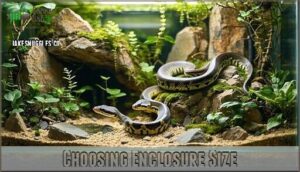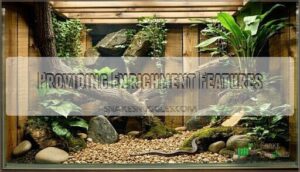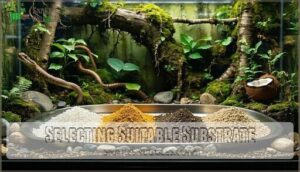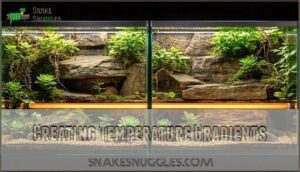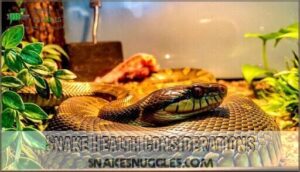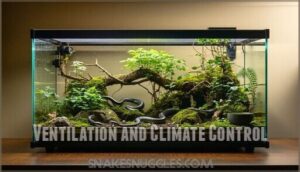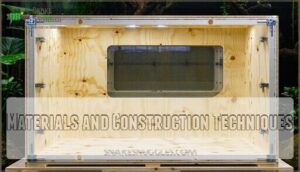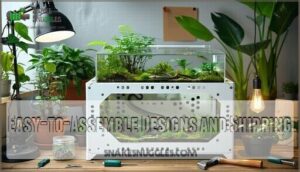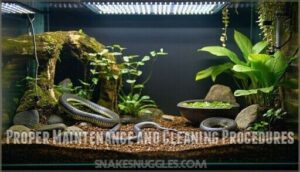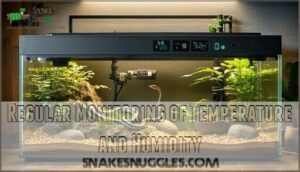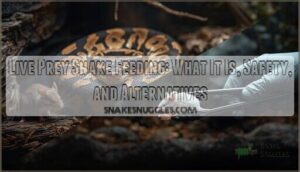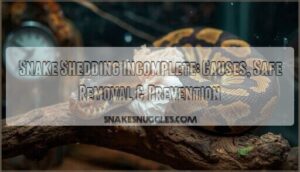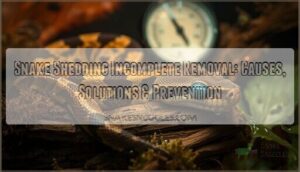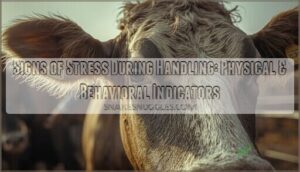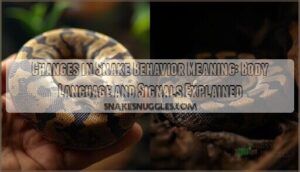This site is supported by our readers. We may earn a commission, at no cost to you, if you purchase through links.
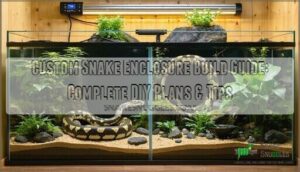 Building a custom snake enclosure gives you complete control over your pet’s environment while often saving money compared to premium commercial options.
Building a custom snake enclosure gives you complete control over your pet’s environment while often saving money compared to premium commercial options.
You’ll need to measure your snake’s current length and account for growth, then design dimensions that provide adequate floor space—typically 40 gallons minimum for most adult species.
Your custom snake enclosure build guide should prioritize proper ventilation placement, temperature gradients from 75-95°F depending on species, and dual hiding spots for security.
Essential features include easy-access panels for maintenance, substrate barriers to prevent escapes, and integrated heating elements.
The key lies in understanding your specific species’ needs—ball pythons require different humidity levels than corn snakes, making customization vital for long-term health and successful keeping.
Table Of Contents
- Key Takeaways
- Choosing Enclosure Size
- Enclosure Design Features
- Snake Health Considerations
- Ventilation and Climate Control
- Building and Maintaining Enclosure
- Frequently Asked Questions (FAQs)
- What is the best material for snake enclosures?
- How to properly set up a snake enclosure?
- What not to put in a snake enclosure?
- Is ABS or PVC better for reptile enclosures?
- How do I create escape-proof snake enclosures?
- Can I include live plants in the habitat?
- What lighting works best for nocturnal snakes?
- Are bioactive setups suitable for all snake species?
- How do I minimize enclosure odors effectively?
- What tools are needed for custom enclosure construction?
- Conclusion
Key Takeaways
- You’ll need to measure your snake’s current length and plan for adult size – enclosures should be at least as long as your snake with 50% extra movement space, typically requiring 40+ gallons for most adult species.
- Your ventilation system must create proper airflow by positioning intake vents low on cool sides and exhaust vents high on warm sides to prevent respiratory infections and maintain 50-70% humidity levels.
- You’ll want to establish temperature gradients from 75-95°F (species-dependent) using heat mats, thermostats, and probe placement, plus provide dual hiding spots on both warm and cool sides for natural thermoregulation.
- You should choose moisture-resistant materials like PVC or sealed plywood, install secure latches and sealed joints to prevent escapes, and maintain consistent cleaning schedules with reptile-safe products for long-term health.
Choosing Enclosure Size
Getting your enclosure size right prevents stress and health issues down the line.
You’ll need to measure your snake’s current length and add space for growth, aiming for an enclosure that’s at least as long as your snake with room to stretch and explore.
This approach ensures that your snake has enough space to stretch and move around comfortably, which is essential for its overall well-being.
Measuring Snake Length
Three simple steps will get you accurate snake length measurements for your custom snake enclosures. First, wait until your snake’s calm and relaxed—stressed snakes won’t cooperate with your measurement tools. Place it on a flat surface and use a flexible tape measure along its body from nose to tail tip for precise length calculations.
Here’s what you need for reliable scaling techniques:
- Flexible measuring tape works better than rigid rulers for curved snake bodies
- Multiple measurements taken over different sessions guarantee consistency and accuracy
- Photo documentation helps track measurements for your growth charts and enclosure size planning
Skip measuring shed skins—they stretch substantially and won’t give you the precision needed for snake enclosure plans suited to your specific snake species.
Accounting for Growth Space
Snake Development affects every custom enclosure decision you’ll make. Growing serpents require Growth Planning that accounts for dramatic size changes – ball pythons double their length, while reticulated pythons increase tenfold.
Space Allocation depends on adult dimensions, not current size. Your Snake Growth research determines final space requirements. Enclosure Scaling through modular panels prevents costly rebuilds as your serpent matures.
| Species | Juvenile Size | Adult Size |
|---|---|---|
| Ball Python | 10-16 inches | 3-5 feet |
| Corn Snake | 8-12 inches | 2-4 feet |
| Reticulated Python | 18-24 inches | 15-25 feet |
Adaptive Design with removable sections accommodates Snake Development stages efficiently. Plan Enclosure Design around maximum adult length plus 50% movement space.
Selecting Optimal Tank Dimensions
Calculate your tank size using proven dimension ratio guidelines – aim for enclosures measuring two-thirds your snake’s adult length.
Space allocation matters: ball pythons need 40-60 gallons while corn snakes thrive in 20-40 gallons.
Consider snake movement patterns when determining enclosure depth – active species require wider footprints.
Your snake enclosure size directly impacts behavior and health.
Smart snake tank setup anticipates growth, preventing costly upgrades.
Follow reptile enclosure design principles that prioritize custom snake tanks with proper enclosure design principles for long-term success.
Enclosure Design Features
Creating a functional snake enclosure requires thoughtful design features that promote your pet’s health and natural behaviors.
You’ll need to balance enrichment elements, proper substrate selection, strategic hiding spots, and temperature control to build an environment that supports your snake’s well-being.
Providing Enrichment Features
Beyond basic housing, environmental enrichment transforms your enclosure into an engaging habitat.
Climbing structures like branches and ledges encourage natural movement patterns, while strategically placed hiding spots provide security zones.
Sensory stimulation through varied textures and surfaces triggers exploratory behavioral triggers.
Rotate substrate options and live plants to maintain novelty.
This environmental enrichment approach reduces stress and promotes natural behaviors, creating a dynamic environment that keeps your snake mentally and physically active.
By incorporating reptile enrichment techniques, you can further enhance the quality of life for your pet snake.
Selecting Suitable Substrate
Choosing the right substrate transforms your snake’s enclosure from basic housing into a comfortable home. Your substrate selection directly impacts your snake’s health, behavior, and overall well-being.
Here are five essential substrate options for ideal snake safety:
- Aspen shavings – excellent burrowing materials with minimal dust and easy spot-cleaning
- Coconut fiber – natural option supporting healthy humidity levels and burrowing materials
- Cypress mulch – ideal moisture-retaining substrates for tropical species requiring higher humidity
- Paper towels – sterile choice for quarantine periods with easy monitoring capabilities
- Reptile-safe soil mixes – perfect for bioactive setups encouraging natural behaviors
Consider substrate depth of 2-4 inches for burrowing species. Avoid cedar or pine shavings due to harmful oils.
Your substrate choices should match your snake’s natural habitat requirements while ensuring easy maintenance and humidity control. When selecting a substrate, researching aspen products can help you make an informed decision about the best material for your snake’s enclosure.
Incorporating Hiding Spots
After selecting proper substrate for your custom snake enclosure, you’ll need strategic hiding spots that satisfy your snake’s security instincts.
These snake hides reduce stress by providing visual barriers and private retreats throughout your reptile habitat design.
- Rock Caves: Natural stone hideouts offer sturdy, temperature-stable refuges that blend seamlessly into your enclosure building guide
- Plant Covers: Live or artificial vegetation creates camouflaged hiding places while enhancing your snake enclosure ideas
- Log Hides: Hollow wood structures provide authentic forest-floor sanctuaries that encourage natural behaviors
Creating Temperature Gradients
Your snake’s well-being depends on proper thermal zones throughout the enclosure.
Install your heat mat under one end’s substrate, creating distinct warm and cool areas.
Position your thermostat probe directly above the heat source for accurate temperature monitoring.
The warm side should maintain 85-90°F for basking, while the cool side stays 75-80°F.
UVB lighting can supplement daytime heating, but ceramic emitters work best for nighttime thermal cycles.
This gradient control setup allows natural thermoregulation, giving your snake freedom to choose ideal temperature control zones.
Snake Health Considerations
A proper enclosure setup directly impacts your snake’s health and can prevent common issues like respiratory infections and shedding problems.
You’ll need to recognize early warning signs and create conditions that support natural behaviors to keep your serpent thriving, which is crucial for preventing issues like respiratory infections.
Common Health Issues in Snakes
Your snake’s health hinges on preventing four devastating Snake Diseases. Respiratory Issues affect 5.6% of captive snakes, causing wheezing and open-mouth breathing from poor ventilation.
Watch for these critical warning signs:
- Respiratory infections with mucus bubbles around nostrils
- Mouth rot showing cheesy discharge and swollen gums
- Parasites appearing as tiny mites near heat pits
- Skin Infections creating dark belly patches from damp conditions
Proper Reptile Care prevents most problems before they start. Understanding snake health basics is essential for identifying potential issues early on.
Recognizing Signs of Illness
Within your enclosure’s controlled environment, Snake Behavior changes serve as early warning signals for health problems.
Watch for Illness Signs like reduced appetite, lethargy, or abnormal posturing during your regular Health Checks.
Respiratory infections cause mouth breathing and wheezing, while mouth rot creates visible lesions around the jaw area.
Parasites often trigger weight loss despite normal feeding schedules.
Stuck shed, discolored scales, or excessive hiding indicate stress or illness requiring immediate attention.
Consistent monitoring supports effective Disease Prevention strategies.
When you notice persistent symptoms, don’t hesitate—prompt Veterinary Care prevents minor issues from becoming serious snake health emergencies that compromise your pet’s wellbeing.
Preventing Respiratory Problems
Your snake’s respiratory health depends on mastering Air Quality and Humidity Control. Poor Ventilation Systems create deadly stagnant pockets where bacteria thrive, turning your enclosure into a breeding ground for Breathing Issues.
Maintain 50-70% humidity levels with strategic ventilation placement and consistent airflow. Position intake vents low, exhaust vents high for natural circulation in your wellventilated area. Wrong substrate choices affect moisture protection, compromising Respiratory Health.
Ventilation Systems require regular monitoring:
- Install digital hygrometers at warm and cool ends for accurate readings
- Clean intake filters weekly to prevent airborne pathogen buildup
- Seal enclosure seams with water resistance materials to control moisture
Weekly disinfection protocols eliminate dangerous airborne pathogens effectively.
Promoting Healthy Shedding
Healthy shedding depends on maintaining humidity levels between 50-60%, spiking to 70-80% during shed cycles.
Your substrate choice should retain moisture without causing moisture damage.
Install textured branches as shedding aids—they’re natural scratching posts.
Proper temperature control and humidity maintenance guarantee your snake’s skin health stays prime throughout the shedding process.
Ventilation and Climate Control
Proper ventilation isn’t just about airflow—it’s the foundation of your snake’s respiratory health and overall comfort.
You’ll need to balance fresh air circulation with humidity retention while preventing drafts that can stress your serpent, which is crucial for maintaining the overall comfort.
Innovative Ventilation Systems
Effective Air Flow transforms your enclosure from a basic box into a thriving ecosystem. Modern Vent Designs integrate seamlessly while maintaining ideal Climate Control through strategic placement and adjustable features.
Here’s your ventilation blueprint:
- Install intake vents on cooler sides using quality ventilation grids for consistent Fresh Air circulation
- Position exhaust vents at warm zones to create natural convection currents and Heat Management
- Add adjustable vent covers to fine-tune airflow and maintain stable humidity levels
- Integrate whisper-quiet fans for enhanced circulation without disturbing your snake’s peace
- Design cross-ventilation patterns that prevent stagnant air while avoiding direct drafts on basking areas
Proper ventilation prevents moisture damage and respiratory issues. Good ventilation means your snake breathes easy while you maintain perfect environmental balance.
Humidity Control and Airflow Management
Proper Airflow Systems depend on strategic Ventilation Holes positioned to create natural air exchange without compromising Humidity Levels.
Install intake vents low on cool sides, exhaust vents high on warm sides for ideal circulation.
| Component | Cool Side | Warm Side | Purpose |
|---|---|---|---|
| Intake Vents | Low Position | None | Fresh air entry |
| Exhaust Vents | None | High Position | Moisture removal |
| Humidity Sensors | Monitor levels | Track gradients | Prevent extremes |
| Moisture Control | Substrate choice | Air Exchange rate | Balance retention |
Moisture-Retaining Substrates like cypress mulch work with controlled Airflow Management to maintain stable conditions.
Your Hygrometer readings guide Ventilation adjustments as seasons change, ensuring consistent environmental control.
Compatible Fans and Vent Covers
Selecting the right fans and vent covers transforms your snake’s enclosure into a perfectly balanced ecosystem. Choose Fan Options with whisper-quiet motors to maintain your serpent’s tranquility while ensuring consistent airflow. Durable Vent Covers crafted from metal or reinforced acrylic resist warping and cracking over time. Quality Air Filters prevent dust buildup while Cooling Systems maintain ideal temperatures year-round.
Install Exhaust Vents with adjustable louvers for precise ventilation control. Seal connections using weatherstripping around each grommet opening, then add decorative trim for a professional finish. Proper sealing prevents air leaks that compromise climate stability.
- Select ultra-quiet fans rated below 20 decibels for noise-sensitive species
- Install corrosion-resistant vent covers with adjustable airflow controls
- Use HEPA-grade air filters to maintain pristine enclosure conditions
- Apply weatherproof sealing around all ventilation penetrations for superior performance
For superior snake enclosure climate control, consider quiet fan options to minimize noise disturbance.
Strategic Vent Placement
Anyone can drill a few holes and call it ventilation, but strategic vent placement in your custom snake enclosure creates a sophisticated airflow management system that keeps your reptile healthy.
Position intake vents low on cooler sides and exhaust vents high on warmer areas—this natural convection drives consistent air circulation throughout your DIY snake terrarium.
Your reptile enclosure plans should account for species-specific humidity regulation needs—ball pythons require different ventilation systems than corn snakes.
Install adjustable vents to fine-tune climate control as seasons change. Use mesh fine enough to prevent escapes while maximizing airflow.
Strategic vent placement prevents stagnant air pockets that harbor bacteria and mold, creating the ideal breathing environment your snake deserves. Proper ventilation design is essential for maintaining a healthy environment and preventing respiratory issues in snakes, see more at ventilation design.
This setup ensures consistent air circulation and helps in preventing respiratory issues. By following these guidelines, you can create a well-ventilated enclosure that meets your snake’s needs.
Building and Maintaining Enclosure
Building your own snake enclosure requires careful material selection and proper construction techniques to guarantee both durability and your snake’s safety.
You’ll need to maintain consistent cleaning schedules and monitor environmental conditions regularly to keep your reptile healthy and thriving.
Materials and Construction Techniques
Your climate control systems are now in place, so let’s focus on selecting materials that’ll withstand years of use. Wood Selection starts with moisture-resistant options like sealed plywood or melamine boards that won’t warp under humidity. Plywood Cutting requires precision—measure twice, cut once to avoid costly mistakes. For accurate cuts, understanding plywood cutting tools is essential.
Key construction steps include:
- Countersinking screw holes prevents sharp edges that could injure your snake
- Sealing all joints with aquarium-safe silicone creates watertight barriers
- PVC Assembly offers superior durability compared to traditional wood methods
Acrylic Sheets provide excellent visibility while resisting scratches better than standard glass. Quality plexiglass panels won’t shatter if accidentally dropped during assembly. Remember, your material choices directly impact both safety and longevity—cheap materials often cost more long-term through repairs and replacements.
Easy-to-Assemble Designs and Shipping
Building your modular enclosures shouldn’t feel like solving a puzzle blindfolded. Flat pack designs with pre-cut components eliminate guesswork and reduce shipping costs substantially.
DIY kits include detailed assembly tips and hardware, making snake terrarium build projects manageable for beginners.
| Design Feature | Benefit |
|---|---|
| Pre-drilled holes | Faster assembly |
| Labeled components | Reduces errors |
| Included hardware | Complete kit solution |
Smart DIY reptile enclosures use lightweight materials that won’t break your budget or your back.
Custom reptile enclosures arrive with clear snake enclosure plans, transforming complex reptile enclosure design into straightforward weekend projects.
Proper Maintenance and Cleaning Procedures
Maintaining your snake enclosure isn’t just about aesthetics—it’s about keeping your slithery companion healthy and thriving.
A healthy habitat starts with consistent care—your snake’s life depends on it.
Proper cleaning schedules and sanitation methods prevent dangerous bacteria buildup while ensuring your pet’s long-term wellbeing.
Your maintenance routine should include:
- Daily spot cleaning removes waste immediately, preventing harmful bacteria growth
- Weekly disinfection using reptile-safe products maintains ideal hygiene practices
- Monthly deep cleaning replaces substrate and sanitizes all surfaces thoroughly
- Ongoing waste removal keeps the environment fresh and odor-free.
Consistent cleaning and maintenance create a healthier habitat for your snake.
Regular Monitoring of Temperature and Humidity
While proper temperature control and hygrometer calibration keep your snake healthy, consistent climate monitoring prevents disasters before they happen.
Install humidity sensors and digital thermometers at both ends of your enclosure to track thermal gradients accurately. Check temperature gradient readings twice daily—your thermoregulation setup depends on stable humidity levels between 50-70% for most species.
Quality hygrometer devices with data logging capabilities let you spot trends and adjust before problems develop. Maintaining essential humidity control systems is vital for the health of your snake, as outlined in proper humidity management.
Frequently Asked Questions (FAQs)
What is the best material for snake enclosures?
Surprisingly, you’ll find that PVC and melamine-coated plywood dominate professional builds for good reason. They’re moisture-resistant, easy-to-clean, and reptile-safe, making your maintenance routine effortless while ensuring your snake’s health.
How to properly set up a snake enclosure?
You’ll want to start with proper substrate selection based on your snake’s natural habitat.
Then establish temperature gradients using heating elements and create secure hiding spots on both warm and cool sides for maximum comfort, ensuring complete concepts are considered for your snake’s well-being.
What not to put in a snake enclosure?
Avoid cedar shavings, sand, newspaper, or aromatic woods that release harmful phenols. Don’t include mirrors, sharp objects, toxic plants, or small items your snake could swallow and choke on.
Is ABS or PVC better for reptile enclosures?
Choosing between these plastic powerhouses, PVC wins the construction championship hands down.
You’ll find PVC easier to cut, drill, and seal than ABS, plus it’s more chemical-resistant and budget-friendly for your reptile’s forever home.
This makes PVC a clear choice for building your reptile’s forever home.
How do I create escape-proof snake enclosures?
Use secure latches, tight-fitting doors, and seal all gaps with silicone caulk. Install mesh ventilation screens and check for openings larger than your snake’s smallest body diameter regularly.
Can I include live plants in the habitat?
Live plants absolutely transform your serpent’s world into a living, breathing paradise.
You can include species like pothos, snake plants, or bromeliads that thrive in humid conditions and won’t harm your snake if nibbled.
What lighting works best for nocturnal snakes?
Red or infrared LED lights work perfectly for nocturnal snakes, letting you observe them without disrupting their natural nighttime behavior.
These wavelengths don’t stress your snake like bright white lights would during their active hours, and are a good choice for viewing snakes at night.
Are bioactive setups suitable for all snake species?
Bioactive setups aren’t suitable for all snake species.
Desert species like ball pythons thrive in bioactive environments, but species requiring sterile conditions or specific substrates may struggle with live plants and microfauna complications.
How do I minimize enclosure odors effectively?
Clean substrate weekly, maintain proper ventilation, spot-clean waste immediately, and use low-humidity substrates like aspen shavings. You’ll prevent bacterial growth that causes most enclosure odors.
What tools are needed for custom enclosure construction?
Picture yourself poised to transform raw materials into your serpent’s perfect sanctuary – but first, you’ll need the right arsenal.
Essential tools include drills, screws, saws (circular or jigsaw), countersink bits, and measuring tools for precise cuts and secure assembly, which are crucial for creating your sanctuary.
Conclusion
Your custom snake enclosure build guide journey ends here, but your snake’s comfort story just begins.
You’ve gained the knowledge to create a habitat that’ll keep your scaly friend thriving for years.
Remember, you’re building more than an enclosure—you’re crafting a home.
Temperature gradients, proper ventilation, and species-specific features aren’t just requirements; they’re your snake’s keys to happiness.
Start measuring, start building, and watch your reptilian companion flourish in their new custom paradise.
- https://www.reddit.com/r/snakes/comments/db4w59/how_much_did_it_cost_to_custom_build_your_larger/
- https://www.animalsathome.ca/diysnakecage-3/
- https://www.hvreptilerescue.org/resources/care-guides/ball-python-care-guide
- https://apexreptile.com/blogs/apex-reptile-blog/best-material-reptile-cage
- https://www.sensorpush.com/articles/temperature-and-humidity-monitoring-for-pet-reptiles-and-amphibians

